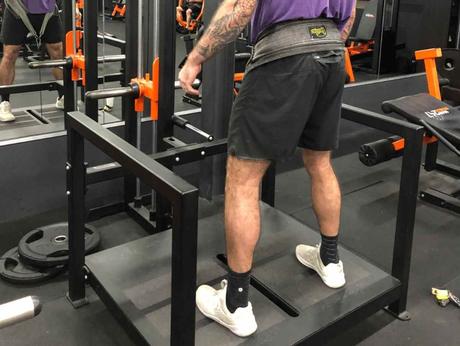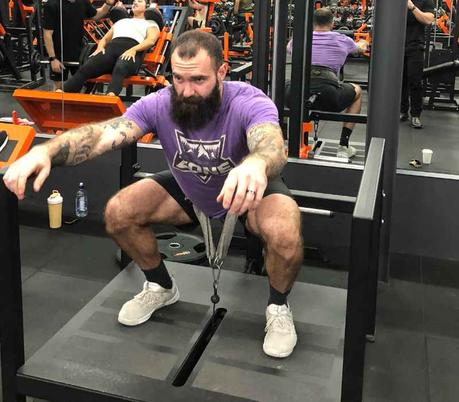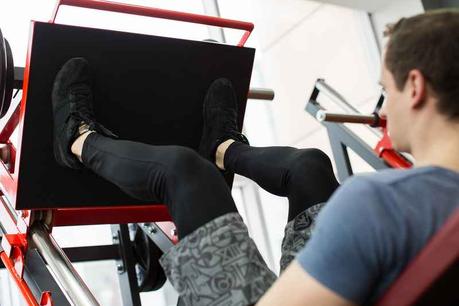Looking for lower body lifts that replicate the benefits of belt squats? Here are the 7 best belt squat alternatives for dominating leg day.

Belt squats are one of the all-time best leg exercises you can do, thanks to their excellent lower body isolation.
However, in order to do belt squats, you’ll need a bit of equipment—including a special belt, a belt squat machine, and a selection of weights—that you just may not have at home.
Heck, not even every commercial gym has a belt squat setup!
Without it, you’ll have to get creative and find other ways to shred your legs safely.
Thankfully, there are a number of belt squat alternatives you can incorporate into your Leg Day sessions to get an excellent lower body workout even without a belt squat machine.
Below, I’ve compiled a list of the best (and my favorite) exercises that will replace (or be an excellent addition to) belt squats. Try them out for yourself and see which help you to build those killer quads and “thicc” thighs you’re working toward!
Let’s get this started.
Why Belt Squats are Awesome
Before we get into the belt squat alternatives, I want to take a moment to talk about the benefits of belt squats so you understand:
A) what makes them such a great choice and
B) what to look for (which we’ll discuss in the next section).
There are two main benefits of belt squats:
 Benefit #1: Excellent Lower Body Muscle Activation
Benefit #1: Excellent Lower Body Muscle Activation

Belt squats have been a staple of lower body weightlifting training for decades, with countless bodybuilders and resistance trainees around the world using it because of how effectively it activates the muscles in your lower body.
One study compared it with back squats and found that “belt squatting provides similar muscular demands for the quadriceps, hamstrings, and plantar flexors.”
While it’s not quite as glute-heavy as back squats, it engages the quads and hamstrings to a comparable degree.
That’s definitely a great reason to add it into your workouts. The more you can engage those legs, the faster you can build those killer quads and powerful hamstrings you want.
But it’s really only when you bring in the next benefit that things really get interesting…

 Benefit #2: Less Core Strain
Benefit #2: Less Core Strain

In that same study mentioned above, the results determined that though belt squats led to similar activation of the primary leg muscles (quads and hamstrings), it was “less demanding of trunk stabilizers, and gluteal muscles”. The study concluded by saying, “Belt squats may be a suitable alternative to back squats in order to avoid stressing low back or trunk musculature.”
As someone who has struggles with back issues and injuries in the past (like so many other weight lifters), this benefit was an absolute game-changer for me!
When I started belt squatting, I was able to lift much higher loads in greater volume, but the risk to my back was virtually nil.
This is because the belt squat places the load on the hips/waist (where the belt rests) rather than loading up the shoulders.
With the load below the level of the trunk (abs and lower back), there is virtually no engagement of the trunk muscles (except for balance purposes) when you squat.
Add to that the handles provided on a belt squat machine to keep you stable, and your upper body is almost entirely removed from the equation.
As a result, lower back injuries are very unlikely while belt squatting.
Like I said: GAME-CHANGER!
What to Look for in a Belt Squat Alternative
Now that we know what the benefits of belt squats are, it’s time to look for other exercises that provide those two benefits. Essentially, a belt squat alternative should:
- Target the lower leg muscles. While belt squats focus chiefly on the quads and hamstrings, more glute-oriented exercises are still important to include in your workout.
- Reduce lower back strain. This is the most critical component of any belt squat alternative! With belt squats, you can work with much higher volumes because all the strain is on your legs, not your lower back. So the best belt squat alternatives will also reduce lower back engagement and keep the focus on your legs as much as possible.
#1 is easy to find—most leg exercises will suffice—but it’s #2 that makes it tough to find belt squat alternatives that are as safe and effective.
As you’ll see by the options below, there are a few exercises that will be a suitable replacement in your workout, though some may require specialized equipment or a modification of your posture/stance/angle of attack to ensure they’re safer for your back.
Belt Squat Alternatives for Leg Day
 Alternative #1: Dip Belt Squat
Alternative #1: Dip Belt Squat

For this exercise, you’ll need just three things:
- A dip belt (easily found at most gyms and available online)
- A selection of barbell plates
- Plyo box or any form of raised platform
Most of this equipment should be available in any commercial gym, and you’ll find it’s fairly easy to stock your home gym with the necessary items listed above. It’s a quick and cheap alternative to belt squats that doesn’t require any sort of machine, and you can do them anytime you want with minimal setup.
To perform this exercise:
- Set the two box jump boxes (or elevated platforms) side by side, with roughly 1 foot of space between them. This will ensure there is space for the weight to dangle between them.
- Mount the platform and stand in a regular squat position, feet spread roughly shoulder width apart, back straight, and arms by your side.
- Secure the dip belt to your waist, and hang the barbell plates of your choice from the chain at the end.
- Inhale as you lower into the squat. The weight should lower between the boxes/platform as you bend at your knees and descend. Lower until your legs hit a 90-degree angle, your thighs parallel to the floor.
- Exhale forcefully as you drive through your heels to push back up.
- Try to finish the squat with a little forward thrust of your hips. (Trainer’s Note: The belt may make it uncomfortable to thrust your hips, so only do it if there is no discomfort.)
- Pause at the top for a 1-count, and begin to inhale as you squat once more.
- Repeat as desired.
Trainer’s Note:
You may find that dip belts aren’t designed to carry as much weight as belt squat belts, so you may have to add extra padding to cushion your waist, and a longer, sturdier chain to add more than 45-pound barbell plates.
 Alternative #2: Landmine Belt Squat
Alternative #2: Landmine Belt Squat

Landmine belt squats are another great alternative for anyone who’s got a moderately sized home gym setup, and it’s definitely an option for a commercial gym.
Really, all you’ll need is a dip belt (the same as you used for the previous exercise), a barbell with sufficient weight, and the landmine attachment for your squat rack or bench.
The beauty of this exercise is that it can be modified to be more glute- or quad-targeted.
Facing away from the landmine will keep the focus on the quads, while facing toward the landmine will engage your glutes more.
To perform this exercise:
- Set up the landmine attachment with the barbell, loading the desired weight onto the long end.
- Wrap the chain of the dip belt around the barbell, just below the weight plate.
- Face away or toward the landmine as desired (depending on glute or quad targeting).
- Inhale as you lower into the squat. Keep your descent slow and controlled, lowering until your knees are bent at a 90-degree angle.
- Exhale forcefully as you drive through your heels to push back up.
- Pause at the top for a 1-count, and begin to inhale as you squat once more.
- Repeat as desired.
 Alternative #3: Leg Press
Alternative #3: Leg Press

There’s no two ways about it: I LOVE the leg press!
Working on the leg press machine makes it easy to load up a lot of weight, and you can easily adapt the focus of the workout by simply shifting your leg press foot placement.
However, because you’re lying on your back, your trunk musculature is largely removed from the equation, and your legs end up doing the majority of the work.

This makes it both excellent at targeting your quads, glutes, and hamstrings while also being much safer for your lower back than standard front or back squats.
To perform this exercise:
- Load up the desired weight on the leg press machine.
- Set the pad/seat/bench to your desired angle.
- Lie on your back and plant your feet on the platform.
- Extend your legs to unrack the weight, lifting it off its cradle. Twist the handles to disengage the safety. Now you’re ready to work!
- Inhale as you bend your knees and lower the weight toward your chest. Stop lowering before your heels lift off the platform and/or your lower back lifts off the seat/pad/bench.
- Exhale forcefully as you drive through your heels to push the weight back up.
- Push until your legs are almost fully extended; NEVER lock out your knees.
- Pause for a 1-count at the top, then inhale as you lower once more.
- Repeat as desired.
 Alternative #4: Hack Squats
Alternative #4: Hack Squats

Hack squats are a bit like front or back squats in the sense that they place the load on your shoulders, so your trunk muscles do have to engage throughout.
However, because of the design of the hack squat machine, there is far less trunk muscle engagement than with standard squats.
Another of the benefits of hack squats that makes it such a great belt squat alternative is the fact that you can go much deeper into the squat and still have the support of the machine.
It’s ideal for safely training in a greater range of motion than any other squat variation.
To perform this exercise:
- Load up the hack squat machine with your desired weight.
- Step onto the angled platform, and place your back against the pads.
- Stand straight to unrack the weight, then use the handle to move the safety mechanism aside.
- Inhale as you lower into the squat. Keep your movements slow and controlled as you descend; dropping too fast can strain your knees and lower back.
- You can stop descending once your knees are bent at a 90-degree angle, or continue a little lower to deepen the squat as desired.
- Exhale forcefully as you drive through your heels to push back up. Straighten until your legs are extended, but stop before your knees lock out.
- Pause at the top for a 1-count, and begin to inhale as you squat once more.
- Repeat as desired.
 Alternative #5: Goblet Squat
Alternative #5: Goblet Squat

Ahh, the goblet squat: a killer exercise for both your legs and your upper body limbs.
Carrying the weight of the dumbbell or kettlebell engages your shoulders and arms in an interesting way, helping to maximize upper body endurance even on Leg Day.
And because you’re holding the weight directly in front of/against your chest, there is far less strain on your lower back throughout the exercise than with front or back squats.
To perform this exercise:
- Stand in the typical squat pose: feet spread roughly shoulder width apart, toes pointed forward, back straight, and head up.
- Grip a kettlebell or dumbbell in both hands, and bring it up to hold against/in front of your chest.
- Inhale as you lower into the squat. Descend slowly and under control.
- Stop once your knees reach 90-degree angle.
- Exhale forcefully as you drive through your heels to push back up. Straighten until your legs are extended, but stop before your knees lock out.
- Pause at the top for a 1-count, and begin to inhale as you squat once more.
- Repeat as desired.
 Alternative #6: Banded Belt Squat
Alternative #6: Banded Belt Squat

The banded belt squat is a fun variation that requires only a dip belt and a set of resistance bands, making it the cheapest and most versatile of the belt squat alternatives.
You can literally pack the equipment to take with you everywhere you go, making it a great lower body exercise to do when traveling or on holiday.
Best of all, it is as effective as belt squats, just without the need for heavy weights.
To perform this exercise:
- Secure the dip belt to your waist. Tie one end of the resistance band/s to your belt, and the other to some solid/secure object at ground level. A bedpost, the base of your squat rack, or the bottom of some heavy piece of equipment will serve your purposes just fine.
- Face away from the anchor point to focus on the quads, and face toward to maximize glute engagement.
- Adopt your squat pose: feet spread roughly shoulder width apart, toes pointed forward, back straight, and head up.
- Inhale as you lower into the squat. Descend slowly and under control.
- Stop once your knees reach 90-degree angle.
- Exhale forcefully as you drive through your heels to push back up. Straighten until your legs are extended, but stop before your knees lock out.
- Pause at the top for a 1-count, and begin to inhale as you squat once more.
- Repeat as desired.
 Alternative #7: Cable Belt Squat
Alternative #7: Cable Belt Squat

Cable belt squats are just like resistance band squats, only they use the cable machine instead of resistance bands.
They’re a great option if your gym or home gym has a cable machine. Because of the cable machine’s design, your muscles spend more time under tension throughout this movement, which leads to maximum hypertrophy and faster muscle growth.
Now that’s a result you can love!
To perform this exercise:
- Secure the dip belt to your waist. Clip the cable machine to your belt, and set it to the lowest possible setting. Set your weight as desired.
- Face away from the anchor point to focus on the quads, and face toward to maximize glute engagement.
- Adopt your squat pose: feet spread roughly shoulder width apart, toes pointed forward, back straight, and head up.
- Inhale as you lower into the squat. Descend slowly and under control.
- Stop once your knees reach 90-degree angle.
- Exhale forcefully as you drive through your heels to push back up. Straighten until your legs are extended, but stop before your knees lock out.
- Pause at the top for a 1-count, and begin to inhale as you squat once more.
- Repeat as desired.
Can you do belt squats at home?
You absolutely can! If you look at the belt squat alternatives we listed above, really the only ones that require machines of any sort are hack squats, leg presses and cable squats.
The other exercises require a dip belt (or belt squat belt) and/or the sort of equipment you’re likely to have at home.
The Bottom Line
Belt squats are one of my all-time favorite leg exercises because of how safe they are for training with lower back injuries while still maximizing leg muscle engagement.
However, if there’s no belt squat machine at your gym or you just don’t have space for another machine at home, you can give these alternatives a try for an equally effective Leg Day training session!
More Belt Squat Guides and Articles
The Best Belt Squat Machines for Epic Lower Body Workouts. Looking for the top belt squat machines on the market for home gyms? Here’s a detailed look at the best options right now, including key features, where to buy, and more.
7 Exercises You Can Do with a Belt Squat Machine. The belt squat machine is a surprisingly versatile for building muscle and strength. Here are seven exercises you can do with the belt squat machine for a full-body workout.
6 Benefits of Belt Squats (And Disadvantages). Belt squats are an excellent exercise for developing lower body muscle and strength. Here are the main benefits of this powerful squat alternative.
